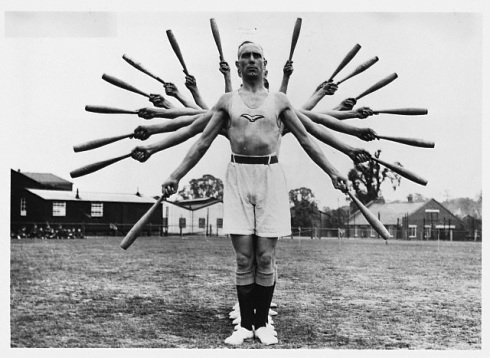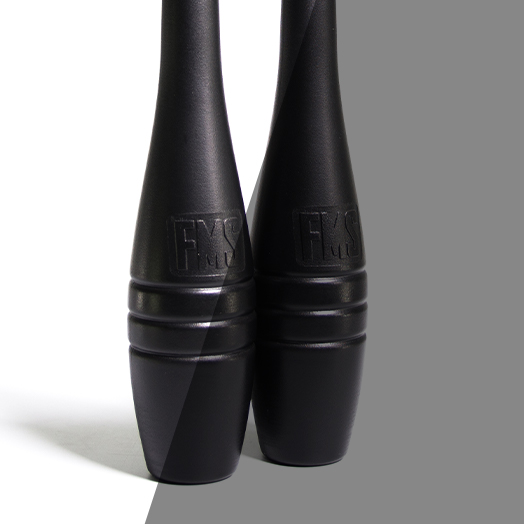Indian Clubs: History and Application
Written by Gray Cook Indian Clubs
INDIAN CLUB SWINGING: A BRIEF HISTORY

Indian Club swinging dates back thousands of years to Hindu traditions. Clubs were considered a gift from divinity in those traditions. The British brought Indian Clubs from India where they were used primarily used as training tools by soldiers and police. In fact, British Marine Physical Instructors are still known as the Clubs. They were introduced in America in the 19th century, and were especially popular during the fitness movement of the Victorian Era. The clubs were widely used, from physical education programs in American schools to military training.
Our partner on Club Swinging Essentials, Dr. Ed Thomas, is one of the foremost experts on club swinging, having studied and practiced the art since the 1950's. He describes the evolution of club swinging as such:
"Imported European functional physical training systems dominated American physical culture throughout the late-1800s until around 1920. “Working out” was not the goal in those earlier systems.
Gymnasia were instead schools where instructors taught theory and practical application of progressively more difficult motor skills. Often divided into restorative, martial and educational (school-based) content, these highly evolved systems emphasized rational progression, variety and precision. Noble goals including service to nation fueled the enormous focus, energy and time required to develop optimal physical structure, function and motion. We can trace much of what is now emerging as functional physical training to these early roots, and much more can be mined from the past if or when we begin to fully appreciate the importance of history in reshaping the present to meet future cultural demands."

Club Swinging was twice contested as an Olympic event (in 1904 and 1932). It was a precursor to Rhythmic Gymnastics, using 3 lb clubs instead of ropes, ribbons and balls used in the modern Olympics.
In the 20th century, Indian Clubs began to fade from training and physical education in favor of sports and games.
You can learn more about the history of Indian Clubs from Brett Jones on episode 188 of Michael Boyle's Strength Coach Podcast (starts at the 31:00 minute mark).
MODERN APPLICATION OF INDIAN CLUBS
I consider the Indian Club an upper body equivalent of jump rope. Jump ropes force posture without me coaching it. You can slouch when you jog, but it's self-limiting with jump rope. Same with the Indian Club.
Self limiting exercise are simply activities that naturally restrict progression without some degree of physical adaptation. The human system has the ability to adapt in two unique ways. The capacity to improve its hardware (physical structure) or software (motor control, coordination and pattern refinement) are interwoven and complementary natural forces. At some point in our history, the basic struggle against natural forces was a dominant teacher.
Call self-limiting exercise and activity an opportunity for stress multitasking. Just pick the appropriate dosage and do the move until you own it! A difficult Turkish getup uses less weight than a difficult shoulder press using a weight machine. This is because the shoulder machine manages all the stress but the downward pushing resistance that follows a predetermined one-size-fits-all movement. Since the responsibility for changing postures, instantaneous balance reactions and sensory awareness is removed, the weight can be increased because other responsibilities have been removed.
When exercise complexity is reduced, the loop between movement perception and movement behavior is reduced. Work is done and calories are burned, but learning and adaptability are not a primary stress.
Western culture has influenced our fitness model more than our authentic or natural movement model has influenced Western culture. We want what we want and we want it now, if not a little sooner. That, in many situations, has produced irresponsible physical education.
The scalability of natural sensory experiences goes back thousands and even millions of years. Our ancestors knew we had the ability to modify our environment, and they also knew we had the natural capacity to adapt.
They entertained that delicate balance between physical adaptability and the modification of the environment. They seemed to intuitively know that things made too easy would not yield the most robust physical results, and that things made too difficult would simply create unnecessary risk. We should learn from them and aim our sights at natural and authentic challenges.
We should take what we learn from our historical natural development and also look at the wisdom on display a mere century ago. With that information in hand, we should realize the gap between ignorance and intelligence is far less than the gap between intelligence and action. Anybody ready for some intelligent action?
Enter Indian Clubs. Dr. Ed Thomas calls it brain training. Performing opposing, alternating and symmetrical patterns lights up neural space and creates learning opportunities.
As a strength coach, I'd like rather create reflex stability than coach stability. We coach movement patterns, but we shouldn't have to coach balance or authentic core reflexes.
In a very sedentary culture, people who overtrain in one direction or don't train at all develop something called Upper and Lower Crossed Syndrome. Basically what happens is that prime movers think they are stabilizers and stabilizers take a vacation.
So how can Indian Clubs help? Glad you asked.
We love to practice Indian Clubs in variations of half-kneeling position. When in half-kneeling, you're forced to use your postural muscles to maintain posture. If you're using your quads to stabilize, it'll be obvious because you won't be able to maintain tall kneeling. When you're standing, you can use a lot of muscles for your posture and they're not always the best to use. In half-kneeling, you'll know if I'm using my hips to manage or my stability to manage. Here's a video from 2011 of myself working with Anthony Renna in the half-kneeling position.
Everyone starts light. Indian Clubs are fast tools. Don't worry so much about the weight. Centrifugal force will take care of that.
In the words of Brett Jones, "I do enough 'heavy' in my training. I didn't need another form of heavy. I needed a restorative art that was going to allow me to have an integrated, mobile and efficient shoulder."
To hear more applications of Indian Club swinging from Brett Jones, check out Episode 199 of The Strength Coach podcast (1:14:55 mark).
Indian Clubs are tremendously versatile tools to build strength, coordination, symmetry and speed. We're excited to bring them back to the forefront with our Introduction to Indian Clubs Online Course.
Please login to leave a comment
1 Comments
-

Andy 8/12/2016 1:41:21 PM
Incredible words and theory, unfortunately again reduced down to promoting a tool (indian clubs) instead of a comprehensive method of restoring authentic natural movement (like MovNat). The loop between movement perception and movement behavior is always reduced without progressively adapting to authentic contextual demands. Wish you guys would team up again!


